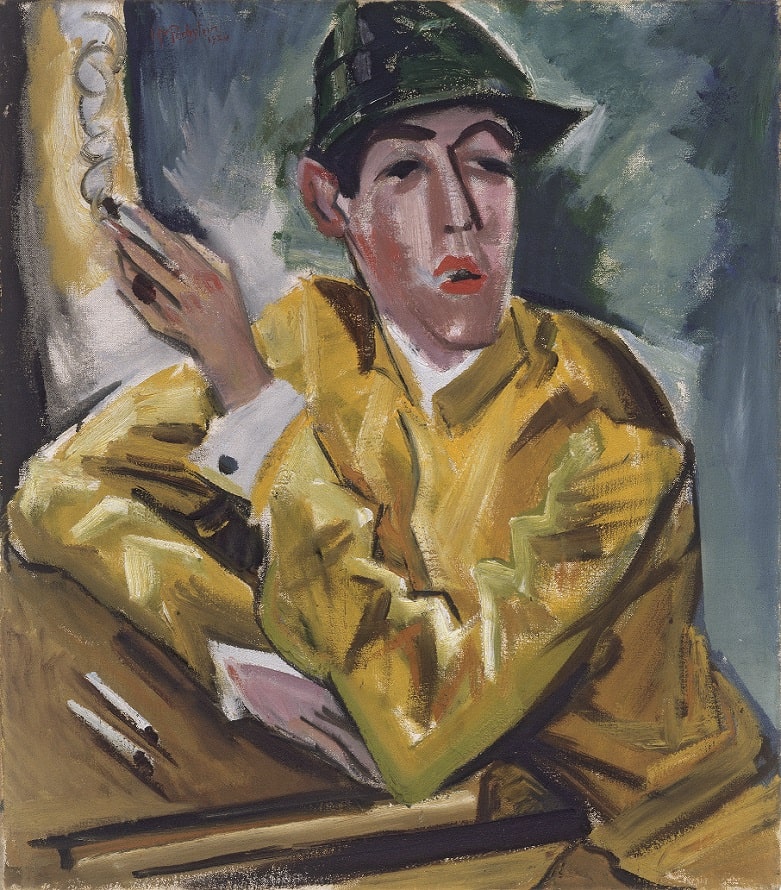Marc Chagall, Wassily Kandinsky, Auguste Renoir, Alexej von Jawlensky, André Derain, Albert Marquet, Max Liebermann, Chaïm Soutine (to whom the Kunstsammlung NRW in Düsseldorf is currently devoting a major solo exhibition), Max Beckmann, Emil Nolde, Oskar Kokoschka, Ernst Ludwig Kirchner, Max Pechstein, Henry van de Velde*: These and other outstanding representatives of the avant-garde movements in art will be presented by the Osthaus Museum from 29 September 2023 to 07 January 2024 in the exhibition “European Avant-Garde – Vision and Reality”.
Fig. above: Max Pechstein, Jockey, 1920, Öl auf Leinwand, 80 x 72 cm, Sammlung Osthaus Museum Hagen, Foto Achim Kukulies, Düsseldorf Kopie
On display are more than 80 works – 60 paintings, five sculptures and a group of works on paper – by French, Belgian, Russian, Ukrainian, Austrian and German artists from the first two decades of the twentieth century.
Parallel to this, a second exhibition entitled “David and Vladimir Burliuk – Masters of Experiments” will show more than 40 works by the Burliuk brothers, who are highly significant for Ukrainian art history. The picture show with works from the years 1909 to 1949 is the first overview exhibition of the brothers in Germany.
In this way, Hagen in Westphalia recalls the great tradition of the Folkwang Museum. Already at the beginning of the twentieth century, artists of the European avant-garde found a fixed point in the city on the edge of the Ruhr region. In 1902, the Folkwang Museum, today’s Osthaus Museum, was opened there, the world’s first museum for contemporary art. Art patron and museum founder Karl Ernst Osthaus, who had amassed a comprehensive collection of paintings and sculptures by Paul Cézanne, Henri Matisse, Éduard Manet, Vincent van Gogh, Auguste Renoir, Kees van Dongen and others, came a great deal closer to his vision of making “beauty once again the ruling power in life” with the founding of the museum.
Tayfun Belgin, director of the Museum Osthaus, emphasises: “We have taken up the Folkwang impulse here, because we remember: Karl Ernst Osthaus exhibited the Brücke artists, who were completely unknown at the time, as early as 1907. Next year, the private collector Osthaus would have turned one hundred and fifty. This exhibition is a tribute to our museum founder. We have realised this large exhibition at great expense for his sake.”
With this double exhibition, the Osthaus Museum not only offers a Western view of the European avant-garde, but also shows the avant-garde movements of the early twentieth century as a pan-European phenomenon.
The art of the avant-garde – the dawn of a new age
The beginning of the twentieth century is marked by profound social upheavals. A new generation of artists tries to take this into account by overcoming the prevailing taste with a new aesthetic.
The artistic avant-garde is regarded as the vanguard of a new movement, which is reflected in various forms such as Expressionism, Fauvism, Cubism, Futurism and Suprematism. The claim: not only to bring about a radical innovation of artistic forms and the individual arts, but at the same time to assert a completely new conception of art and a new positioning of art in society.
The Hagen exhibition brings together the different positions of these artists and pays homage to their history of influence. For example, the Expressionists have influenced later generations – up to the wild painting of the 1970s and 1980s – and Suprematism has found a renaissance in US art on a large scale.
The period of the avant-gardes is and remains an important chapter in the history of modern art and continues to radiate into the art world and beyond.
David und Vladimir Burliuk
The brothers David Burliuk, born in 1882 in the Kharkiv governorate, and Vladimir Burliuk, born there in 1886, are of great importance for Ukrainian art history. Both were avant-garde artists who were not only interested in innovations but also implemented them. Vladimir, who died in the First World War at the age of 32, is known as a neo-primitivist and cubo-futurist, while David is considered the father of Russian Futurism. From 1922 David Burliuk lived in the USA, where he exerted a great influence on the American art scene. He died on Long Island in 1967.
The two exhibitions are made possible by the generous support of private lenders: two collectors from London who wish to maintain their anonymity, the collector Inna Bazhenova from Monaco and the collector couple Maya and Anatoly Bekkerman from New York. 21 works, including works by the Burliuk brothers, are in the collection of the Museum Osthaus. Both exhibitions are curated by Joseph Kiblitsky and Tayfun Belgin.
About the Osthaus Museum
The Folkwang Museum opened its doors in the Westphalian industrial town of Hagen in the summer of 1902. It owed its foundation to an art-minded, wealthy man: Karl Ernst Osthaus. The Folkwang soon achieved fame as the world’s first museum for contemporary art.
Dr Tayfun Belgin, Director Osthaus Museum Hagen: “The Osthaus Museum exists to show, through its very special history as well as its current exhibition practice, that passionate commitment to art and culture brings joy, creates quality of life and brings people together. Our museum offers dynamic experiences that illuminate the power and enduring significance of art in today’s global society.”
The museum aims to interest and excite people in South Westphalia, the Ruhr region and across Germany about the Osthaus Museum, its important collection of modern and contemporary art and its special exhibitions. Therefore, the Osthaus Museum offers a high quality of stay and conveys an awareness of art and the constitutive role of the viewer in an entertaining and lively way.
WHERE?
Osthaus Museum Hagen
Museumspl. 1
58095 Hagen
WHEN?
Friday, 29.09.2023 – Sunday, 07.01.2024






